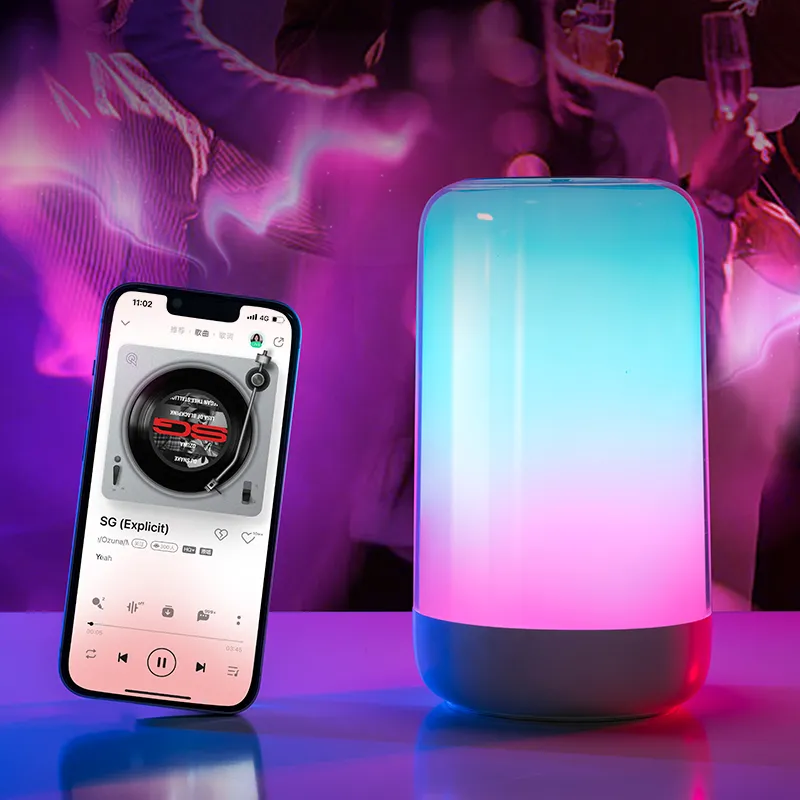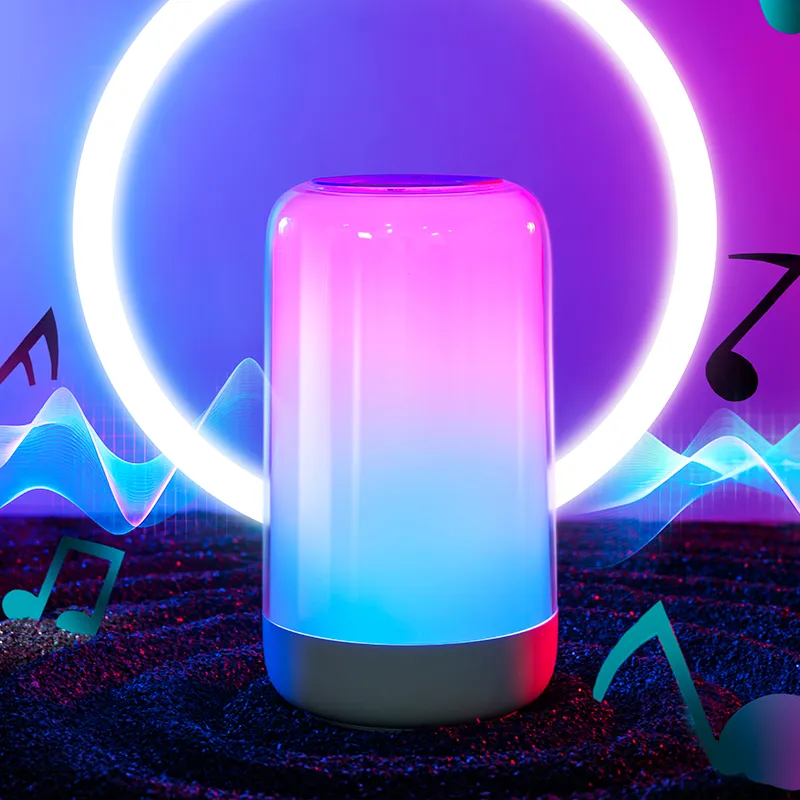What is an RGB night light?
In modern home and lifestyle lighting, night lights have evolved from simple illumination tools to products that both create atmosphere and provide functional support. RGB night lights, in particular, have garnered significant attention in recent years.
So, what is an RGB night light? How is it different from ordinary night lights? Why are color-changing LED night lights becoming a common choice in many homes? This article provides an in-depth explanation from a professional perspective.

What is an RGB night light?
An RGB night light is a night lighting fixture that uses a combination of red, green, and blue primary colors to achieve a variety of color changes. Unlike traditional night lights that emit only a single warm or cool light, RGB night lights can produce a rich variety of color effects.
Color-changing LED night lights are a typical example of RGB night lights. They leverage the controllable nature of LED light sources to create diverse lighting atmospheres by adjusting the ratio of the three primary colors. From purely functional lighting to creating a warm, romantic, cozy, or even dreamy ambiance, RGB night lights are capable of accommodating a wide range of needs. In short, an RGB night light uses technology to enable it to change color, extending its functionality beyond just illumination.
RGB Night Light: How Does Color Change Work?
To understand what an RGB night light is, you must understand how it works.
1. The Principle of RGB Tricolor Light Superposition
• Red, green, and blue are the three primary colors in optics. By superimposing these three colors at varying intensities, we can create nearly every color visible to the human eye.
• For example: red + green = yellow; red + blue = purple; and a mixture of the three colors in equal proportions = white.
Therefore, by adjusting the ratio of red, green, and blue, RGB night lights can achieve a variety of lighting variations.
2. Controllability of LED Light Sources
Due to technical limitations, traditional light bulbs are difficult to achieve arbitrary color changes. However, color-changing LED night lights utilize semiconductor light-emitting technology, enabling rapid changes in brightness and color ratios under electronic control, making it easy to create dozens or even hundreds of color combinations.
3. Control Methods
RGB night lights typically offer a variety of control methods:
• Physical buttons: Change colors by toggling a button.
• Remote control: Remotely select color and brightness.
• Touch control: Switch colors with a touch of a finger.
These different control methods make RGB night lights not only practical but also fun.

RGB night lights vs. regular night lights: What's the difference?
To understand what an RGB night light is, it's important to compare it with a traditional night light.
1. Color Performance
• Regular night lights: Typically offer a fixed warm or cool white light.
• RGB night lights: Can change colors to suit different scenarios.
2. Functionality
• Regular night lights: Primarily used for nighttime illumination, making it easier to wake up at night or providing a safe light source.
• Color-changing LED night lights: Beyond basic lighting, they can also serve as ambient lighting, decorative lighting, and even as a soothing device for children.
3. Operational Experience
• Ordinary night lights: Single function, simple on/off operation.
• RGB night lights: Offer diverse functions like color adjustment and dimming, offering more intelligent operation.
4. Visual Effects
• Ordinary night lights: Monotonous light, lacking a sense of ambiance.
• Color-changing LED night lights: Rich colors, flexible to suit mood and surroundings, greatly enhancing the comfort of the home.
Thus, RGB night lights are essentially an "advanced" version of night lights, their unique feature being their color-changing function.

What are the main features of RGB night lights?
1. Multi-Color Change
RGB night lights can display dozens or even hundreds of colors. Some color-changing LED night lights even feature automatic color cycling, creating a dynamic, time-varying effect in the space.
2. Adjustable Brightness
Unlike traditional night lights with fixed brightness levels, RGB night lights typically offer adjustable brightness. Parents can use them in a baby's room by lowering the brightness to create a quiet atmosphere and then increasing it for reading or activities.
3. Energy-Saving and Environmentally Friendly
Color-Changing LED Night Lights use LED light sources, which consume far less energy than traditional incandescent or fluorescent lamps and generate less heat, making them more environmentally friendly.
4. High Safety
Due to their low operating voltage, LED night lights offer enhanced safety, making them suitable for spaces with high safety requirements, such as children's rooms and bedrooms.
5. Creating Ambiance
The colorful lighting effects of RGB night lights can create a different atmosphere in bedrooms, living rooms, and children's rooms, making the nights less monotonous.
What are the applications of RGB night lights?
1. Children's Rooms
Children often have a fear of the dark at night. Color-Changing LED night lights provide soft light and changeable colors, which can both soothe and add fun.
2. Bedrooms
Adult bedrooms can use RGB night lights to adjust the light color to suit different moods. Warm light is ideal for falling asleep, cool light is suitable for reading, and colorful light is suitable for relaxing.
3. Living Room and Decoration
RGB night lights are not limited to functional lighting; they can also serve as decorative elements, brightening up corners of the living room and creating a warm or romantic atmosphere.
4. Nighttime Safety Lighting
Placing color-changing LED night lights in hallways and stairwells provides soft illumination while avoiding glare, ensuring nighttime safety.

How to Choose the Right RGB Night Light?
Now that you understand what RGB night lights are, parents and consumers should consider scientific criteria when purchasing.
1. Moderate Brightness: Too high a brightness can disrupt sleep, while too low can be ineffective. It is generally recommended to keep the brightness within the range of 5-20 lx.
2. Color Temperature and Light Effect: When choosing a color-changing LED night light, ensure it has a warm light mode between 2700K and 3000K, suitable for sleeping.
3. Control Options: A high-quality RGB night light should support multiple dimming levels and color-changing modes for easy operation.
4. Safety and Materials: Choose products made of scald-resistant, drop-resistant, and environmentally friendly materials to avoid potential safety hazards.
5. Power Supply: RGB night lights offer a variety of power supply options, including plug-in, rechargeable, and induction. For home use, choose the right one based on the scenario.
What is an RGB night light?
RGB night lights are nighttime lighting products that utilize the three primary colors of red, green, and blue (RGB) and use LED light sources to achieve multi-color switching and create an atmosphere. Compared to ordinary night lights, they offer more functionality, greater flexibility, and a more pronounced ambiance.
Color-changing LED night lights, in particular, have become the epitome of RGB night lights. They not only meet basic nighttime lighting needs but also offer a variety of lighting options, creating a comfortable, safe, and welcoming user experience.
How does Huari Lighting support long-term business partnerships?
At Huari Lighting, we focus on building trust with our customers. Our factory ensures steady supply, competitive wholesale prices, and strict product quality for long-term cooperation. Many international brands continue purchasing from us because we provide reliable manufacturing, timely promotions, and flexible customization.
